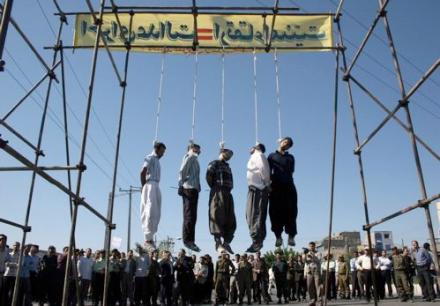
A few weeks ago, at the instigation of Amnesty International (AI), demonstrations were held in some 20 countries around the world protesting the execution of juveniles in Iran. According to figures published by AI, the number of executions in Iran rose from 94 in 2005 to 346 in 2008. That is, during Mahmoud Ahmadinejad’s tenure as Iran’s President, the number has tripled. In the first three months of this year, 120 individuals have received the death penalty. Iran now boasts the highest number of executions after China.
Under the Islamic Republic’s legal and judicial system, the country’s Judiciary is the branch which is responsible for executing capital punishment. Yet the steep rise in death sentences under Ahmadinejad makes one wonder: is this accidental or related to the current administration’s overall policies? It appears to be the latter.
Many of the executions are the direct result of policies pursued by the administration. As an example, one can cite the arrest and subsequent executions of “hooligans” and “rogue elements” under the so-called Social Safety Program, the implementation of which, endorsed by the Iranian President, dates back to 2007. When on June 27th, 2007, Ahmadinejad’s administration disregarded the recommendations of economists and announced gas rationing, people protested and riots erupted. Hundreds of protesters who took to the streets were arrested under this plan. On July 22, 2007, Tehran’s notorious prosecutor, Saeid Mortazavi, announced the execution of 16 detainees and ordered the death penalty for another 17.
The sharp rise in the number of death penalties in Iran must be viewed in the context of other radical efforts of the last four years, all of which have been articulated an d justified as calls for “decisiveness in treating criminals”, “no retreat to satisfy the West”, or, adopting “revolutionary measures inside the country.” Responsible for this hard-line approach have of course been no other than Mahmoud Ahmadinejad and his administration.
This uncompromising stand has not been confined to the executive branch. Over the last four years, Iran’s Supreme Leader, Ayatollah Khamenei, has publicly supported this line. On August 24, 2008, Khamenei criticized some of the officials of the former government saying they were “reactive and ashamed in their encounter vis-à-vis the ambitious foreigners,” and lauded Ahmadinejad’s government emphasizing that this government has been able to “block the very dangerous trend of pro-Westernization and secular tendencies which were unfortunately infiltrating the structure of the administration of the country.”
Thus, it is only natural that Ahmadinejad’s stance, endorsed by the Supreme Leader, is pursued by all branches of the government, including the Judiciary.
A good example of judicial compliance with this model is the resistance a number of judges have shown against ending violent sentences, such as stoning. Thus, although in February 2003, head of Iran’s Judiciary, Shahrudi, se nt out a circular urging the courts to replace stoning with other forms of punishment, after 2005, a number of judges have continued this medieval practice with vigor. Some of them, in an obvious attempt to ensuring that stoning orders would be carried out, have even “hidden” the court verdicts from the public. Such was the case of Ja’far Kiani who was stoned to death on July 6, 2007, in the town of Takestan in northwestern Iran.
These judges know very well that so long as the atmosphere in the country is that of “non-compromise”, and non- tolerance, they will not be questioned on their way of carrying “justice” under the “ divine laws” or the Sharia.
In implementing the Sharia law, the Islamic Republic is sending several messages to both their own people and the outside world. To those living in Iran, the message is: we are in control and we insist on implementing the true teachings of Islam; do not deviate from it. The me ssage to the West is: do not try to introduce your laws, because here in Iran, the law of the divine is practiced, and if in the process we have the highest executions per capita in the world, so be it.
If Ahmadinejad is re-elected in June 2009, Tehran’s record-breaking level of unspeakable forms of punishment will likely continue for another four years. Another term for Ahmadinejad means the continued strangulation of the Iranian society under the pretext of “Islamic Justice”, a harsher life for the majority of the people in Iran and the denial of their most basic human rights.
AUTHORS
Hossein Bastani, a member of the editorial board of Rooz online and the former Secretary General of the Association of Iranian Journalists, the only nationwide syndicate of journalists in Iran
Fariba Amini, journalist, human rights activist and author of “Faces of Successful Iranian Americans”, published by the US Department of State.






